Environmental Sustainability Assignment (Doc)
VerifiedAdded on 2020/05/03
|11
|3436
|63
AI Summary
Contribute Materials
Your contribution can guide someone’s learning journey. Share your
documents today.

UNIVERSITY NAME
Student’s name
Student’s ID
Sustainability
Student’s name
Student’s ID
Sustainability
Secure Best Marks with AI Grader
Need help grading? Try our AI Grader for instant feedback on your assignments.
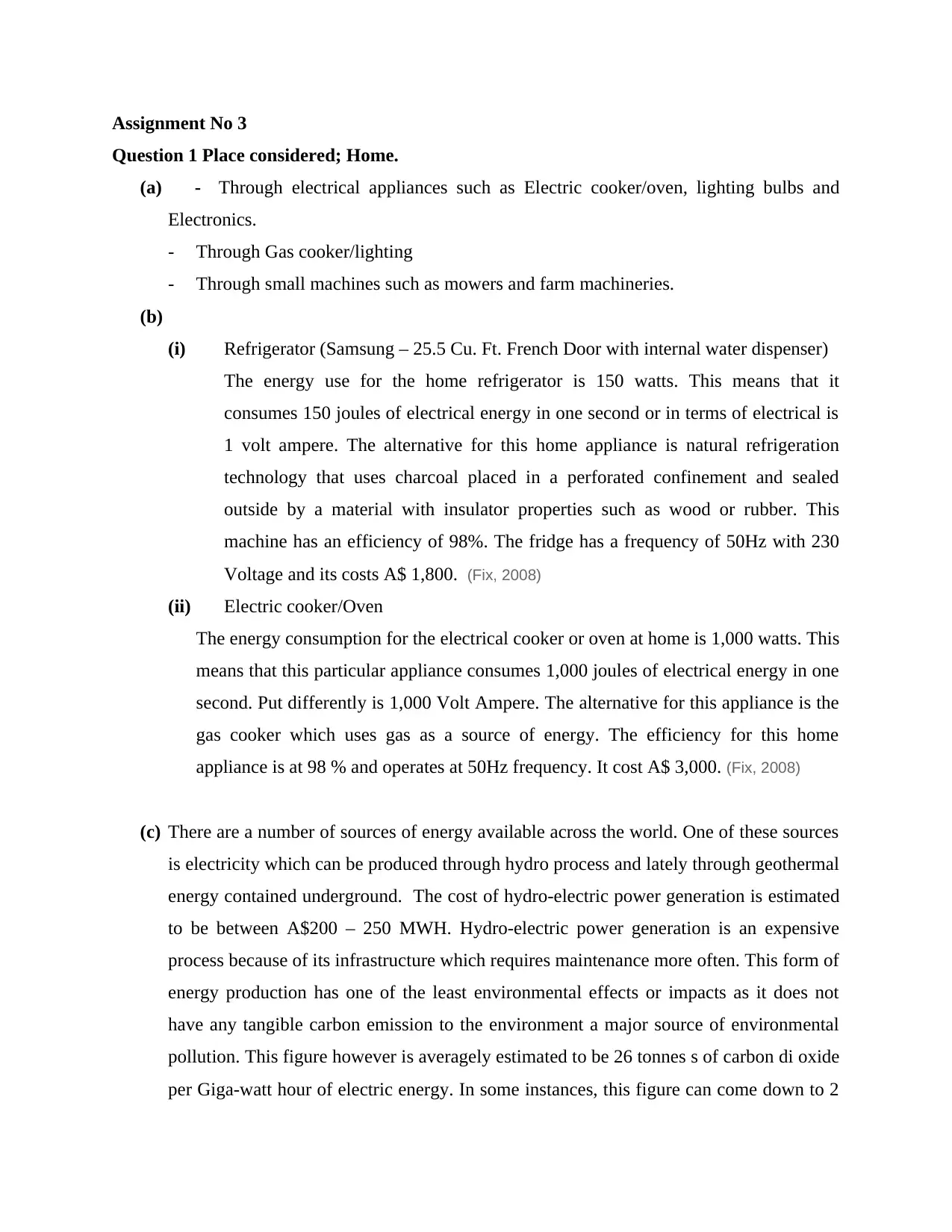
Assignment No 3
Question 1 Place considered; Home.
(a) - Through electrical appliances such as Electric cooker/oven, lighting bulbs and
Electronics.
- Through Gas cooker/lighting
- Through small machines such as mowers and farm machineries.
(b)
(i) Refrigerator (Samsung – 25.5 Cu. Ft. French Door with internal water dispenser)
The energy use for the home refrigerator is 150 watts. This means that it
consumes 150 joules of electrical energy in one second or in terms of electrical is
1 volt ampere. The alternative for this home appliance is natural refrigeration
technology that uses charcoal placed in a perforated confinement and sealed
outside by a material with insulator properties such as wood or rubber. This
machine has an efficiency of 98%. The fridge has a frequency of 50Hz with 230
Voltage and its costs A$ 1,800. (Fix, 2008)
(ii) Electric cooker/Oven
The energy consumption for the electrical cooker or oven at home is 1,000 watts. This
means that this particular appliance consumes 1,000 joules of electrical energy in one
second. Put differently is 1,000 Volt Ampere. The alternative for this appliance is the
gas cooker which uses gas as a source of energy. The efficiency for this home
appliance is at 98 % and operates at 50Hz frequency. It cost A$ 3,000. (Fix, 2008)
(c) There are a number of sources of energy available across the world. One of these sources
is electricity which can be produced through hydro process and lately through geothermal
energy contained underground. The cost of hydro-electric power generation is estimated
to be between A$200 – 250 MWH. Hydro-electric power generation is an expensive
process because of its infrastructure which requires maintenance more often. This form of
energy production has one of the least environmental effects or impacts as it does not
have any tangible carbon emission to the environment a major source of environmental
pollution. This figure however is averagely estimated to be 26 tonnes s of carbon di oxide
per Giga-watt hour of electric energy. In some instances, this figure can come down to 2
Question 1 Place considered; Home.
(a) - Through electrical appliances such as Electric cooker/oven, lighting bulbs and
Electronics.
- Through Gas cooker/lighting
- Through small machines such as mowers and farm machineries.
(b)
(i) Refrigerator (Samsung – 25.5 Cu. Ft. French Door with internal water dispenser)
The energy use for the home refrigerator is 150 watts. This means that it
consumes 150 joules of electrical energy in one second or in terms of electrical is
1 volt ampere. The alternative for this home appliance is natural refrigeration
technology that uses charcoal placed in a perforated confinement and sealed
outside by a material with insulator properties such as wood or rubber. This
machine has an efficiency of 98%. The fridge has a frequency of 50Hz with 230
Voltage and its costs A$ 1,800. (Fix, 2008)
(ii) Electric cooker/Oven
The energy consumption for the electrical cooker or oven at home is 1,000 watts. This
means that this particular appliance consumes 1,000 joules of electrical energy in one
second. Put differently is 1,000 Volt Ampere. The alternative for this appliance is the
gas cooker which uses gas as a source of energy. The efficiency for this home
appliance is at 98 % and operates at 50Hz frequency. It cost A$ 3,000. (Fix, 2008)
(c) There are a number of sources of energy available across the world. One of these sources
is electricity which can be produced through hydro process and lately through geothermal
energy contained underground. The cost of hydro-electric power generation is estimated
to be between A$200 – 250 MWH. Hydro-electric power generation is an expensive
process because of its infrastructure which requires maintenance more often. This form of
energy production has one of the least environmental effects or impacts as it does not
have any tangible carbon emission to the environment a major source of environmental
pollution. This figure however is averagely estimated to be 26 tonnes s of carbon di oxide
per Giga-watt hour of electric energy. In some instances, this figure can come down to 2
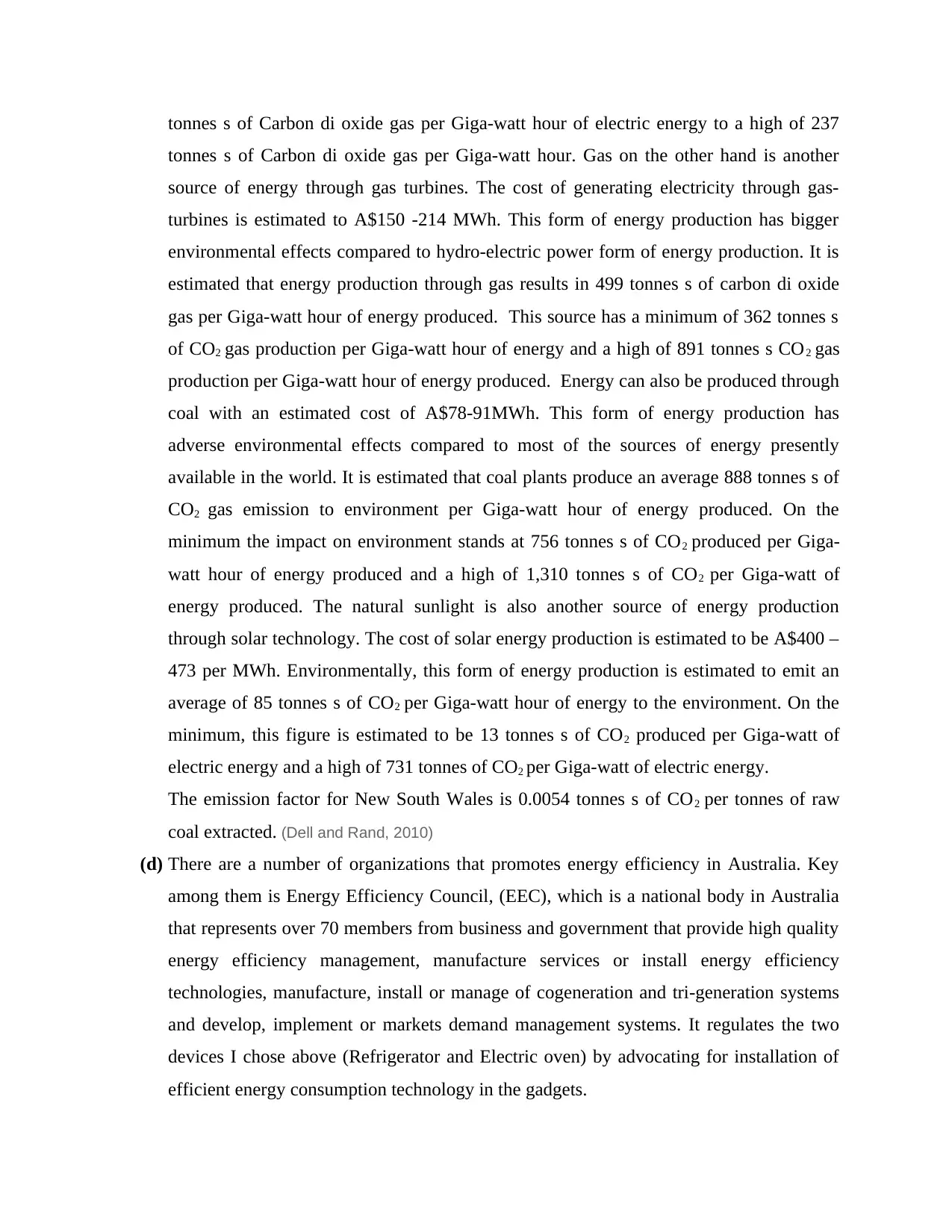
tonnes s of Carbon di oxide gas per Giga-watt hour of electric energy to a high of 237
tonnes s of Carbon di oxide gas per Giga-watt hour. Gas on the other hand is another
source of energy through gas turbines. The cost of generating electricity through gas-
turbines is estimated to A$150 -214 MWh. This form of energy production has bigger
environmental effects compared to hydro-electric power form of energy production. It is
estimated that energy production through gas results in 499 tonnes s of carbon di oxide
gas per Giga-watt hour of energy produced. This source has a minimum of 362 tonnes s
of CO2 gas production per Giga-watt hour of energy and a high of 891 tonnes s CO2 gas
production per Giga-watt hour of energy produced. Energy can also be produced through
coal with an estimated cost of A$78-91MWh. This form of energy production has
adverse environmental effects compared to most of the sources of energy presently
available in the world. It is estimated that coal plants produce an average 888 tonnes s of
CO2 gas emission to environment per Giga-watt hour of energy produced. On the
minimum the impact on environment stands at 756 tonnes s of CO2 produced per Giga-
watt hour of energy produced and a high of 1,310 tonnes s of CO2 per Giga-watt of
energy produced. The natural sunlight is also another source of energy production
through solar technology. The cost of solar energy production is estimated to be A$400 –
473 per MWh. Environmentally, this form of energy production is estimated to emit an
average of 85 tonnes s of CO2 per Giga-watt hour of energy to the environment. On the
minimum, this figure is estimated to be 13 tonnes s of CO2 produced per Giga-watt of
electric energy and a high of 731 tonnes of CO2 per Giga-watt of electric energy.
The emission factor for New South Wales is 0.0054 tonnes s of CO2 per tonnes of raw
coal extracted. (Dell and Rand, 2010)
(d) There are a number of organizations that promotes energy efficiency in Australia. Key
among them is Energy Efficiency Council, (EEC), which is a national body in Australia
that represents over 70 members from business and government that provide high quality
energy efficiency management, manufacture services or install energy efficiency
technologies, manufacture, install or manage of cogeneration and tri-generation systems
and develop, implement or markets demand management systems. It regulates the two
devices I chose above (Refrigerator and Electric oven) by advocating for installation of
efficient energy consumption technology in the gadgets.
tonnes s of Carbon di oxide gas per Giga-watt hour. Gas on the other hand is another
source of energy through gas turbines. The cost of generating electricity through gas-
turbines is estimated to A$150 -214 MWh. This form of energy production has bigger
environmental effects compared to hydro-electric power form of energy production. It is
estimated that energy production through gas results in 499 tonnes s of carbon di oxide
gas per Giga-watt hour of energy produced. This source has a minimum of 362 tonnes s
of CO2 gas production per Giga-watt hour of energy and a high of 891 tonnes s CO2 gas
production per Giga-watt hour of energy produced. Energy can also be produced through
coal with an estimated cost of A$78-91MWh. This form of energy production has
adverse environmental effects compared to most of the sources of energy presently
available in the world. It is estimated that coal plants produce an average 888 tonnes s of
CO2 gas emission to environment per Giga-watt hour of energy produced. On the
minimum the impact on environment stands at 756 tonnes s of CO2 produced per Giga-
watt hour of energy produced and a high of 1,310 tonnes s of CO2 per Giga-watt of
energy produced. The natural sunlight is also another source of energy production
through solar technology. The cost of solar energy production is estimated to be A$400 –
473 per MWh. Environmentally, this form of energy production is estimated to emit an
average of 85 tonnes s of CO2 per Giga-watt hour of energy to the environment. On the
minimum, this figure is estimated to be 13 tonnes s of CO2 produced per Giga-watt of
electric energy and a high of 731 tonnes of CO2 per Giga-watt of electric energy.
The emission factor for New South Wales is 0.0054 tonnes s of CO2 per tonnes of raw
coal extracted. (Dell and Rand, 2010)
(d) There are a number of organizations that promotes energy efficiency in Australia. Key
among them is Energy Efficiency Council, (EEC), which is a national body in Australia
that represents over 70 members from business and government that provide high quality
energy efficiency management, manufacture services or install energy efficiency
technologies, manufacture, install or manage of cogeneration and tri-generation systems
and develop, implement or markets demand management systems. It regulates the two
devices I chose above (Refrigerator and Electric oven) by advocating for installation of
efficient energy consumption technology in the gadgets.
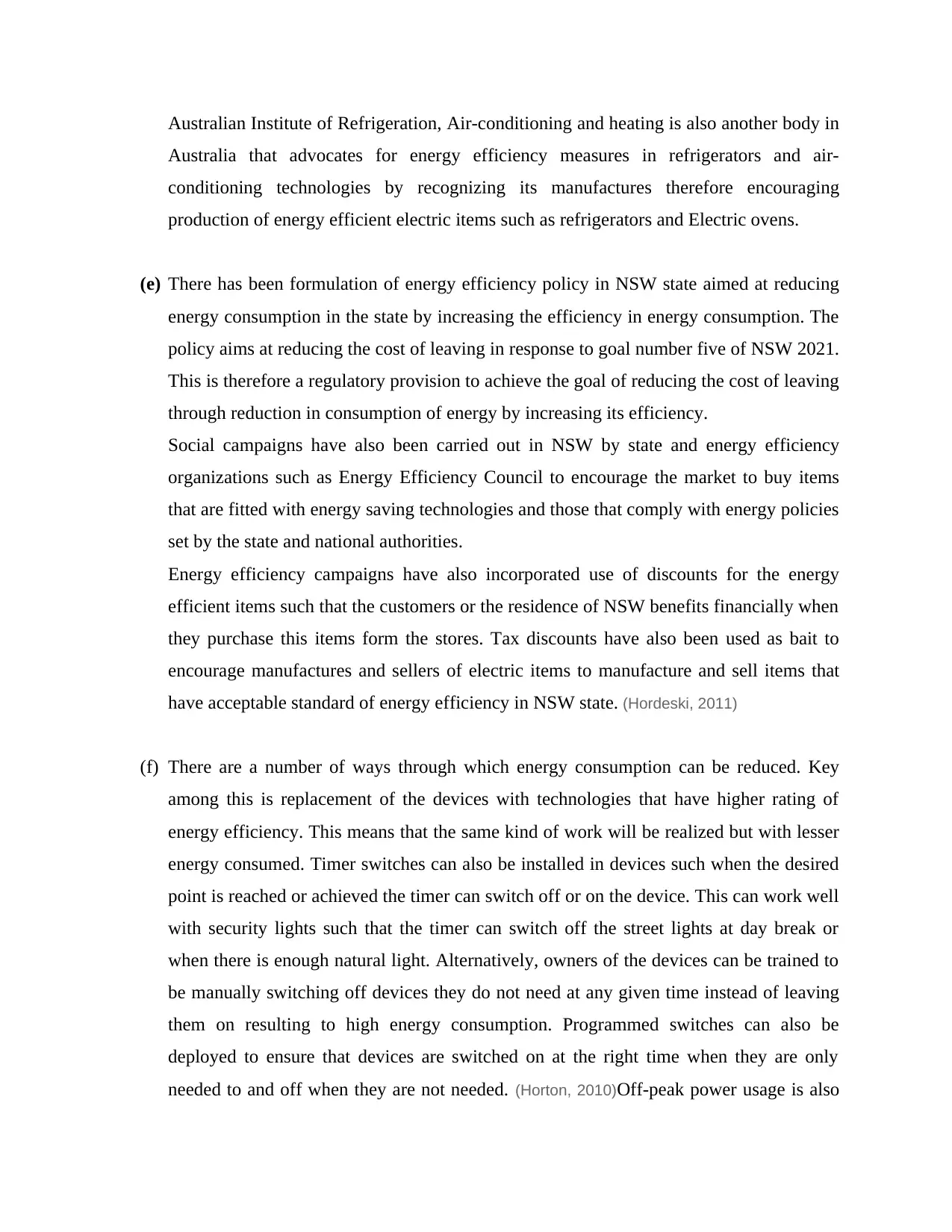
Australian Institute of Refrigeration, Air-conditioning and heating is also another body in
Australia that advocates for energy efficiency measures in refrigerators and air-
conditioning technologies by recognizing its manufactures therefore encouraging
production of energy efficient electric items such as refrigerators and Electric ovens.
(e) There has been formulation of energy efficiency policy in NSW state aimed at reducing
energy consumption in the state by increasing the efficiency in energy consumption. The
policy aims at reducing the cost of leaving in response to goal number five of NSW 2021.
This is therefore a regulatory provision to achieve the goal of reducing the cost of leaving
through reduction in consumption of energy by increasing its efficiency.
Social campaigns have also been carried out in NSW by state and energy efficiency
organizations such as Energy Efficiency Council to encourage the market to buy items
that are fitted with energy saving technologies and those that comply with energy policies
set by the state and national authorities.
Energy efficiency campaigns have also incorporated use of discounts for the energy
efficient items such that the customers or the residence of NSW benefits financially when
they purchase this items form the stores. Tax discounts have also been used as bait to
encourage manufactures and sellers of electric items to manufacture and sell items that
have acceptable standard of energy efficiency in NSW state. (Hordeski, 2011)
(f) There are a number of ways through which energy consumption can be reduced. Key
among this is replacement of the devices with technologies that have higher rating of
energy efficiency. This means that the same kind of work will be realized but with lesser
energy consumed. Timer switches can also be installed in devices such when the desired
point is reached or achieved the timer can switch off or on the device. This can work well
with security lights such that the timer can switch off the street lights at day break or
when there is enough natural light. Alternatively, owners of the devices can be trained to
be manually switching off devices they do not need at any given time instead of leaving
them on resulting to high energy consumption. Programmed switches can also be
deployed to ensure that devices are switched on at the right time when they are only
needed to and off when they are not needed. (Horton, 2010)Off-peak power usage is also
Australia that advocates for energy efficiency measures in refrigerators and air-
conditioning technologies by recognizing its manufactures therefore encouraging
production of energy efficient electric items such as refrigerators and Electric ovens.
(e) There has been formulation of energy efficiency policy in NSW state aimed at reducing
energy consumption in the state by increasing the efficiency in energy consumption. The
policy aims at reducing the cost of leaving in response to goal number five of NSW 2021.
This is therefore a regulatory provision to achieve the goal of reducing the cost of leaving
through reduction in consumption of energy by increasing its efficiency.
Social campaigns have also been carried out in NSW by state and energy efficiency
organizations such as Energy Efficiency Council to encourage the market to buy items
that are fitted with energy saving technologies and those that comply with energy policies
set by the state and national authorities.
Energy efficiency campaigns have also incorporated use of discounts for the energy
efficient items such that the customers or the residence of NSW benefits financially when
they purchase this items form the stores. Tax discounts have also been used as bait to
encourage manufactures and sellers of electric items to manufacture and sell items that
have acceptable standard of energy efficiency in NSW state. (Hordeski, 2011)
(f) There are a number of ways through which energy consumption can be reduced. Key
among this is replacement of the devices with technologies that have higher rating of
energy efficiency. This means that the same kind of work will be realized but with lesser
energy consumed. Timer switches can also be installed in devices such when the desired
point is reached or achieved the timer can switch off or on the device. This can work well
with security lights such that the timer can switch off the street lights at day break or
when there is enough natural light. Alternatively, owners of the devices can be trained to
be manually switching off devices they do not need at any given time instead of leaving
them on resulting to high energy consumption. Programmed switches can also be
deployed to ensure that devices are switched on at the right time when they are only
needed to and off when they are not needed. (Horton, 2010)Off-peak power usage is also
Secure Best Marks with AI Grader
Need help grading? Try our AI Grader for instant feedback on your assignments.
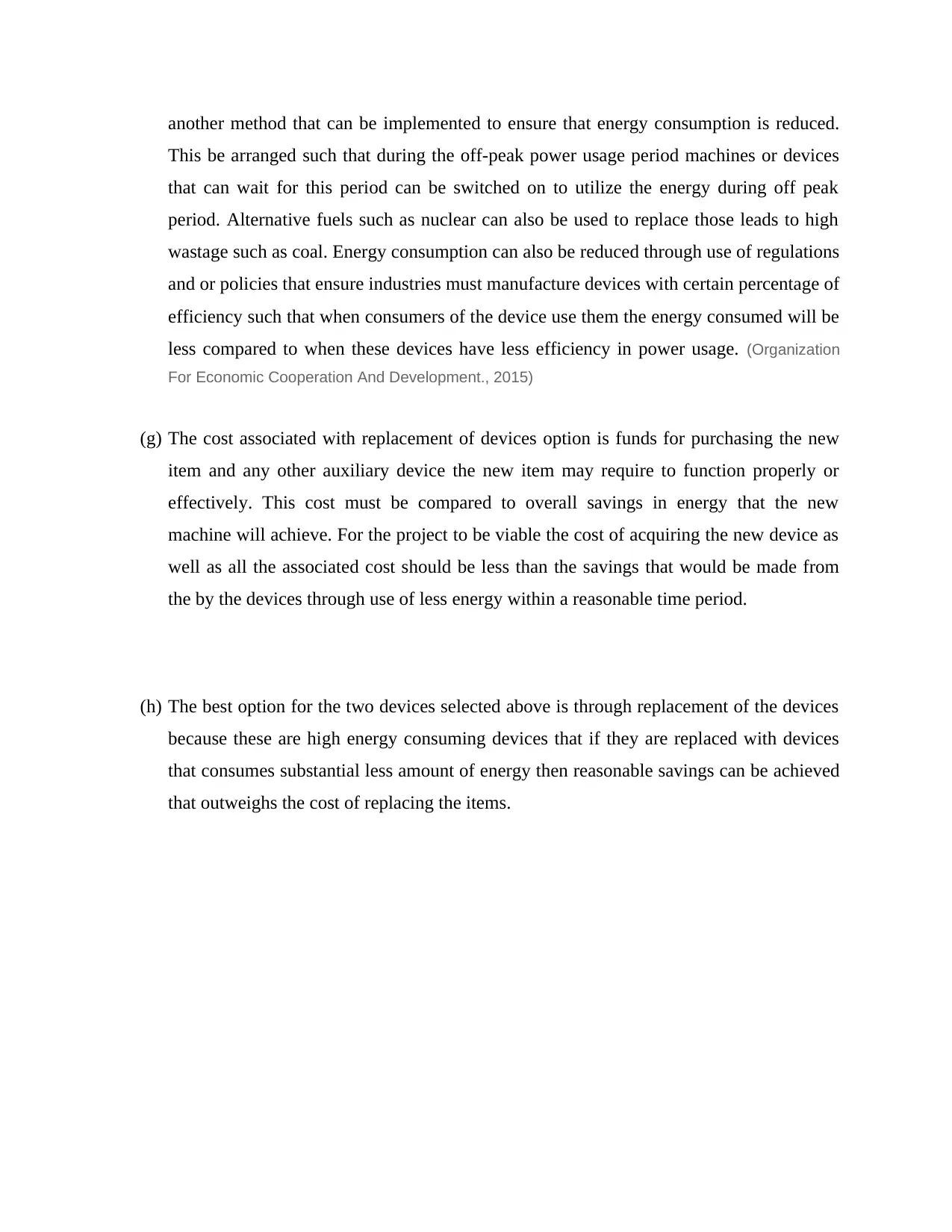
another method that can be implemented to ensure that energy consumption is reduced.
This be arranged such that during the off-peak power usage period machines or devices
that can wait for this period can be switched on to utilize the energy during off peak
period. Alternative fuels such as nuclear can also be used to replace those leads to high
wastage such as coal. Energy consumption can also be reduced through use of regulations
and or policies that ensure industries must manufacture devices with certain percentage of
efficiency such that when consumers of the device use them the energy consumed will be
less compared to when these devices have less efficiency in power usage. (Organization
For Economic Cooperation And Development., 2015)
(g) The cost associated with replacement of devices option is funds for purchasing the new
item and any other auxiliary device the new item may require to function properly or
effectively. This cost must be compared to overall savings in energy that the new
machine will achieve. For the project to be viable the cost of acquiring the new device as
well as all the associated cost should be less than the savings that would be made from
the by the devices through use of less energy within a reasonable time period.
(h) The best option for the two devices selected above is through replacement of the devices
because these are high energy consuming devices that if they are replaced with devices
that consumes substantial less amount of energy then reasonable savings can be achieved
that outweighs the cost of replacing the items.
This be arranged such that during the off-peak power usage period machines or devices
that can wait for this period can be switched on to utilize the energy during off peak
period. Alternative fuels such as nuclear can also be used to replace those leads to high
wastage such as coal. Energy consumption can also be reduced through use of regulations
and or policies that ensure industries must manufacture devices with certain percentage of
efficiency such that when consumers of the device use them the energy consumed will be
less compared to when these devices have less efficiency in power usage. (Organization
For Economic Cooperation And Development., 2015)
(g) The cost associated with replacement of devices option is funds for purchasing the new
item and any other auxiliary device the new item may require to function properly or
effectively. This cost must be compared to overall savings in energy that the new
machine will achieve. For the project to be viable the cost of acquiring the new device as
well as all the associated cost should be less than the savings that would be made from
the by the devices through use of less energy within a reasonable time period.
(h) The best option for the two devices selected above is through replacement of the devices
because these are high energy consuming devices that if they are replaced with devices
that consumes substantial less amount of energy then reasonable savings can be achieved
that outweighs the cost of replacing the items.
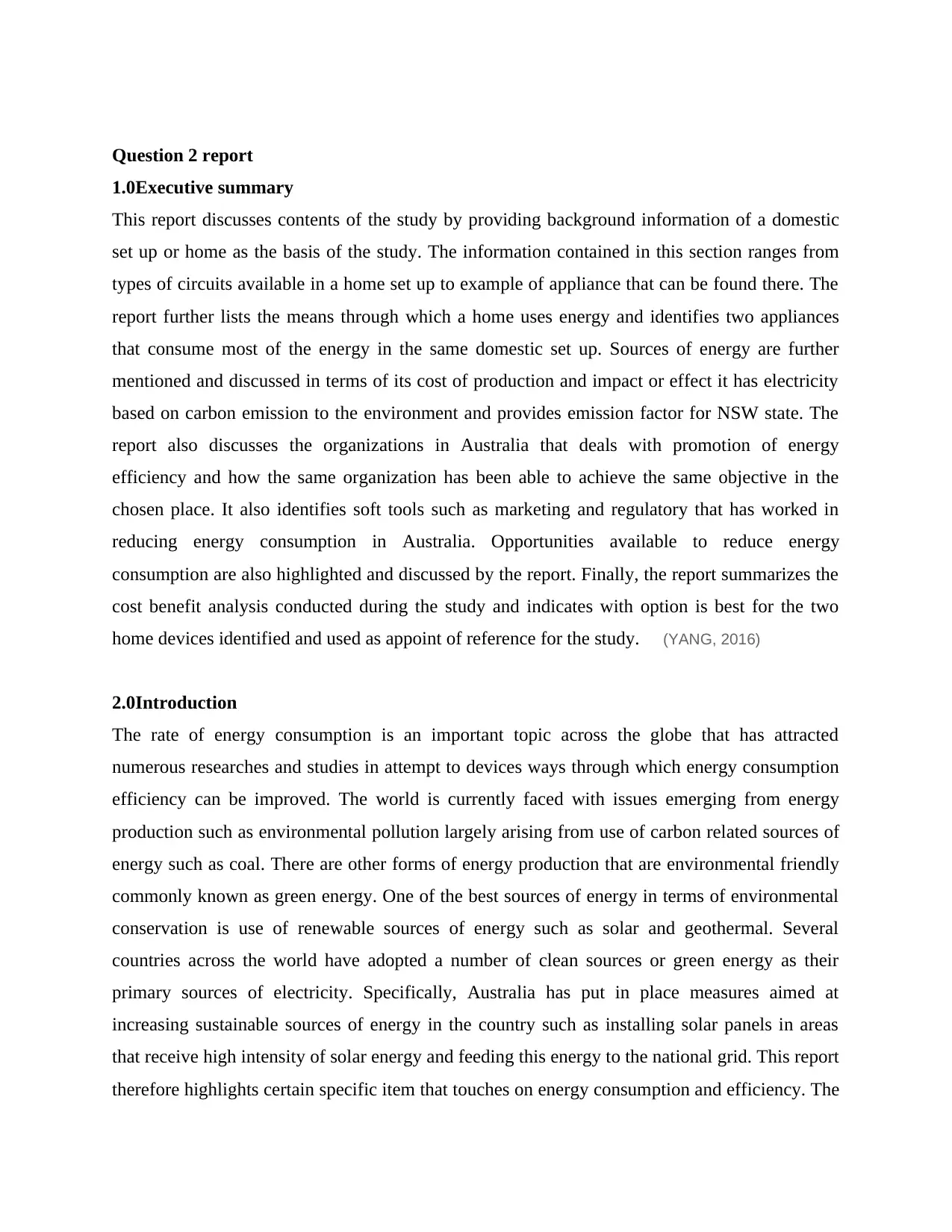
Question 2 report
1.0Executive summary
This report discusses contents of the study by providing background information of a domestic
set up or home as the basis of the study. The information contained in this section ranges from
types of circuits available in a home set up to example of appliance that can be found there. The
report further lists the means through which a home uses energy and identifies two appliances
that consume most of the energy in the same domestic set up. Sources of energy are further
mentioned and discussed in terms of its cost of production and impact or effect it has electricity
based on carbon emission to the environment and provides emission factor for NSW state. The
report also discusses the organizations in Australia that deals with promotion of energy
efficiency and how the same organization has been able to achieve the same objective in the
chosen place. It also identifies soft tools such as marketing and regulatory that has worked in
reducing energy consumption in Australia. Opportunities available to reduce energy
consumption are also highlighted and discussed by the report. Finally, the report summarizes the
cost benefit analysis conducted during the study and indicates with option is best for the two
home devices identified and used as appoint of reference for the study. (YANG, 2016)
2.0Introduction
The rate of energy consumption is an important topic across the globe that has attracted
numerous researches and studies in attempt to devices ways through which energy consumption
efficiency can be improved. The world is currently faced with issues emerging from energy
production such as environmental pollution largely arising from use of carbon related sources of
energy such as coal. There are other forms of energy production that are environmental friendly
commonly known as green energy. One of the best sources of energy in terms of environmental
conservation is use of renewable sources of energy such as solar and geothermal. Several
countries across the world have adopted a number of clean sources or green energy as their
primary sources of electricity. Specifically, Australia has put in place measures aimed at
increasing sustainable sources of energy in the country such as installing solar panels in areas
that receive high intensity of solar energy and feeding this energy to the national grid. This report
therefore highlights certain specific item that touches on energy consumption and efficiency. The
1.0Executive summary
This report discusses contents of the study by providing background information of a domestic
set up or home as the basis of the study. The information contained in this section ranges from
types of circuits available in a home set up to example of appliance that can be found there. The
report further lists the means through which a home uses energy and identifies two appliances
that consume most of the energy in the same domestic set up. Sources of energy are further
mentioned and discussed in terms of its cost of production and impact or effect it has electricity
based on carbon emission to the environment and provides emission factor for NSW state. The
report also discusses the organizations in Australia that deals with promotion of energy
efficiency and how the same organization has been able to achieve the same objective in the
chosen place. It also identifies soft tools such as marketing and regulatory that has worked in
reducing energy consumption in Australia. Opportunities available to reduce energy
consumption are also highlighted and discussed by the report. Finally, the report summarizes the
cost benefit analysis conducted during the study and indicates with option is best for the two
home devices identified and used as appoint of reference for the study. (YANG, 2016)
2.0Introduction
The rate of energy consumption is an important topic across the globe that has attracted
numerous researches and studies in attempt to devices ways through which energy consumption
efficiency can be improved. The world is currently faced with issues emerging from energy
production such as environmental pollution largely arising from use of carbon related sources of
energy such as coal. There are other forms of energy production that are environmental friendly
commonly known as green energy. One of the best sources of energy in terms of environmental
conservation is use of renewable sources of energy such as solar and geothermal. Several
countries across the world have adopted a number of clean sources or green energy as their
primary sources of electricity. Specifically, Australia has put in place measures aimed at
increasing sustainable sources of energy in the country such as installing solar panels in areas
that receive high intensity of solar energy and feeding this energy to the national grid. This report
therefore highlights certain specific item that touches on energy consumption and efficiency. The
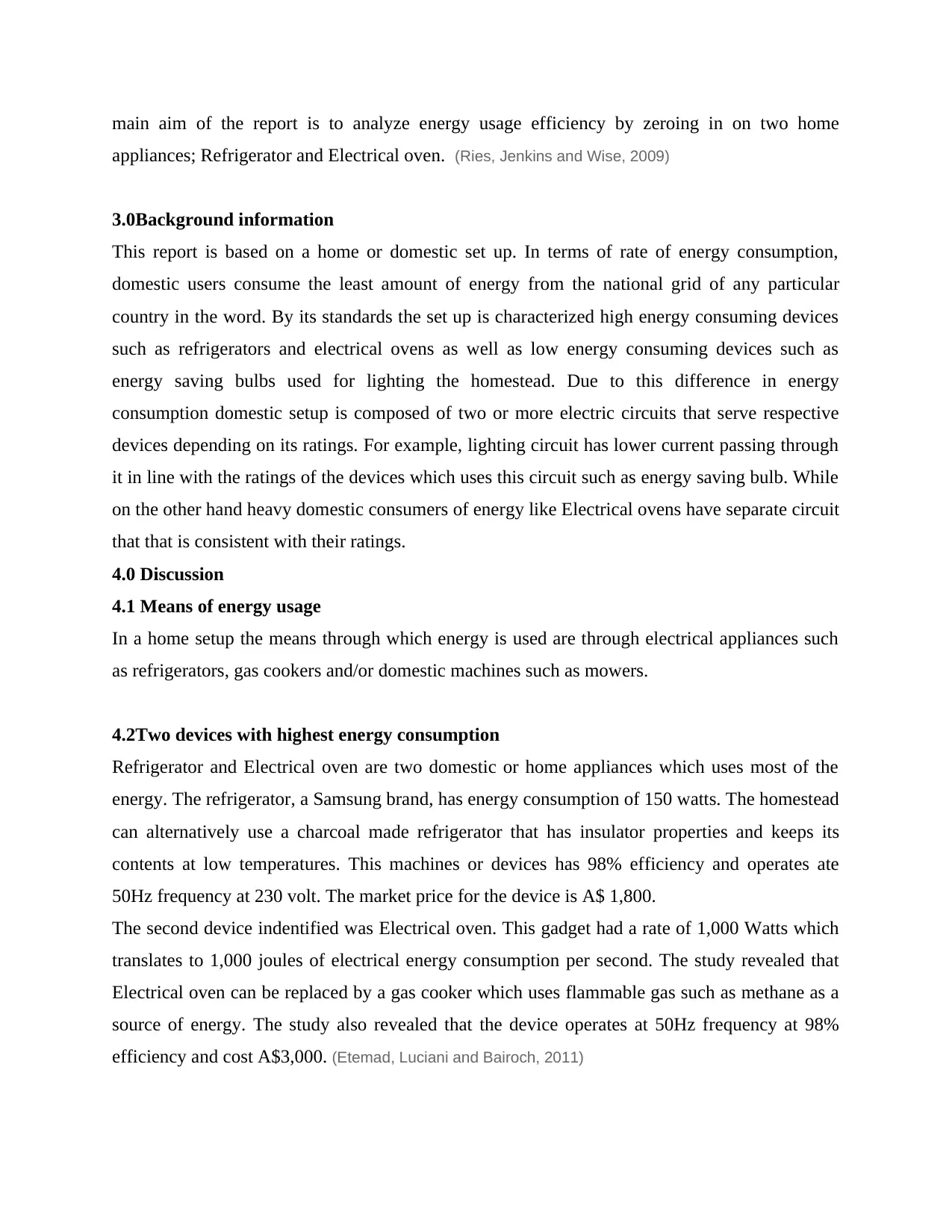
main aim of the report is to analyze energy usage efficiency by zeroing in on two home
appliances; Refrigerator and Electrical oven. (Ries, Jenkins and Wise, 2009)
3.0Background information
This report is based on a home or domestic set up. In terms of rate of energy consumption,
domestic users consume the least amount of energy from the national grid of any particular
country in the word. By its standards the set up is characterized high energy consuming devices
such as refrigerators and electrical ovens as well as low energy consuming devices such as
energy saving bulbs used for lighting the homestead. Due to this difference in energy
consumption domestic setup is composed of two or more electric circuits that serve respective
devices depending on its ratings. For example, lighting circuit has lower current passing through
it in line with the ratings of the devices which uses this circuit such as energy saving bulb. While
on the other hand heavy domestic consumers of energy like Electrical ovens have separate circuit
that that is consistent with their ratings.
4.0 Discussion
4.1 Means of energy usage
In a home setup the means through which energy is used are through electrical appliances such
as refrigerators, gas cookers and/or domestic machines such as mowers.
4.2Two devices with highest energy consumption
Refrigerator and Electrical oven are two domestic or home appliances which uses most of the
energy. The refrigerator, a Samsung brand, has energy consumption of 150 watts. The homestead
can alternatively use a charcoal made refrigerator that has insulator properties and keeps its
contents at low temperatures. This machines or devices has 98% efficiency and operates ate
50Hz frequency at 230 volt. The market price for the device is A$ 1,800.
The second device indentified was Electrical oven. This gadget had a rate of 1,000 Watts which
translates to 1,000 joules of electrical energy consumption per second. The study revealed that
Electrical oven can be replaced by a gas cooker which uses flammable gas such as methane as a
source of energy. The study also revealed that the device operates at 50Hz frequency at 98%
efficiency and cost A$3,000. (Etemad, Luciani and Bairoch, 2011)
appliances; Refrigerator and Electrical oven. (Ries, Jenkins and Wise, 2009)
3.0Background information
This report is based on a home or domestic set up. In terms of rate of energy consumption,
domestic users consume the least amount of energy from the national grid of any particular
country in the word. By its standards the set up is characterized high energy consuming devices
such as refrigerators and electrical ovens as well as low energy consuming devices such as
energy saving bulbs used for lighting the homestead. Due to this difference in energy
consumption domestic setup is composed of two or more electric circuits that serve respective
devices depending on its ratings. For example, lighting circuit has lower current passing through
it in line with the ratings of the devices which uses this circuit such as energy saving bulb. While
on the other hand heavy domestic consumers of energy like Electrical ovens have separate circuit
that that is consistent with their ratings.
4.0 Discussion
4.1 Means of energy usage
In a home setup the means through which energy is used are through electrical appliances such
as refrigerators, gas cookers and/or domestic machines such as mowers.
4.2Two devices with highest energy consumption
Refrigerator and Electrical oven are two domestic or home appliances which uses most of the
energy. The refrigerator, a Samsung brand, has energy consumption of 150 watts. The homestead
can alternatively use a charcoal made refrigerator that has insulator properties and keeps its
contents at low temperatures. This machines or devices has 98% efficiency and operates ate
50Hz frequency at 230 volt. The market price for the device is A$ 1,800.
The second device indentified was Electrical oven. This gadget had a rate of 1,000 Watts which
translates to 1,000 joules of electrical energy consumption per second. The study revealed that
Electrical oven can be replaced by a gas cooker which uses flammable gas such as methane as a
source of energy. The study also revealed that the device operates at 50Hz frequency at 98%
efficiency and cost A$3,000. (Etemad, Luciani and Bairoch, 2011)
Paraphrase This Document
Need a fresh take? Get an instant paraphrase of this document with our AI Paraphraser
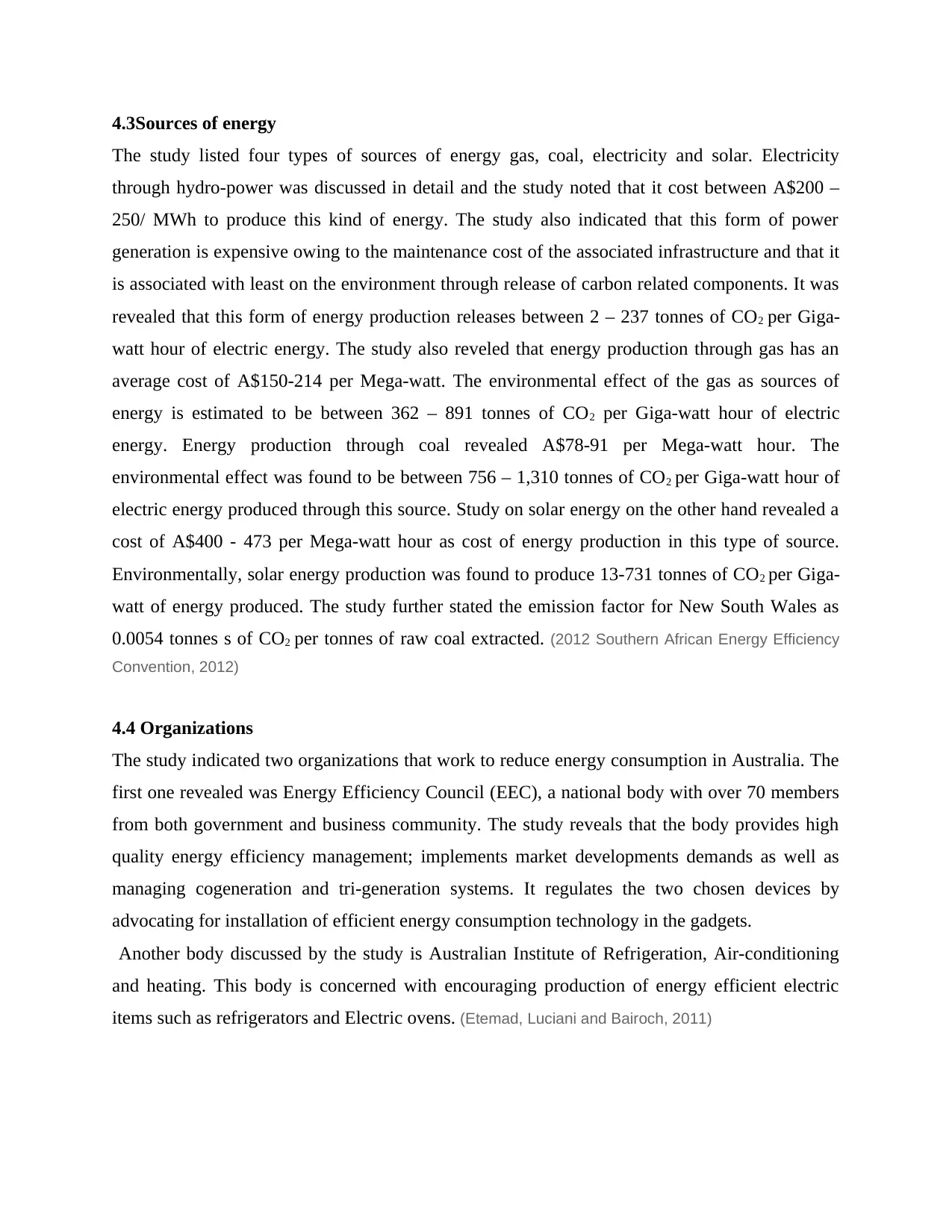
4.3Sources of energy
The study listed four types of sources of energy gas, coal, electricity and solar. Electricity
through hydro-power was discussed in detail and the study noted that it cost between A$200 –
250/ MWh to produce this kind of energy. The study also indicated that this form of power
generation is expensive owing to the maintenance cost of the associated infrastructure and that it
is associated with least on the environment through release of carbon related components. It was
revealed that this form of energy production releases between 2 – 237 tonnes of CO2 per Giga-
watt hour of electric energy. The study also reveled that energy production through gas has an
average cost of A$150-214 per Mega-watt. The environmental effect of the gas as sources of
energy is estimated to be between 362 – 891 tonnes of CO2 per Giga-watt hour of electric
energy. Energy production through coal revealed A$78-91 per Mega-watt hour. The
environmental effect was found to be between 756 – 1,310 tonnes of CO2 per Giga-watt hour of
electric energy produced through this source. Study on solar energy on the other hand revealed a
cost of A$400 - 473 per Mega-watt hour as cost of energy production in this type of source.
Environmentally, solar energy production was found to produce 13-731 tonnes of CO2 per Giga-
watt of energy produced. The study further stated the emission factor for New South Wales as
0.0054 tonnes s of CO2 per tonnes of raw coal extracted. (2012 Southern African Energy Efficiency
Convention, 2012)
4.4 Organizations
The study indicated two organizations that work to reduce energy consumption in Australia. The
first one revealed was Energy Efficiency Council (EEC), a national body with over 70 members
from both government and business community. The study reveals that the body provides high
quality energy efficiency management; implements market developments demands as well as
managing cogeneration and tri-generation systems. It regulates the two chosen devices by
advocating for installation of efficient energy consumption technology in the gadgets.
Another body discussed by the study is Australian Institute of Refrigeration, Air-conditioning
and heating. This body is concerned with encouraging production of energy efficient electric
items such as refrigerators and Electric ovens. (Etemad, Luciani and Bairoch, 2011)
The study listed four types of sources of energy gas, coal, electricity and solar. Electricity
through hydro-power was discussed in detail and the study noted that it cost between A$200 –
250/ MWh to produce this kind of energy. The study also indicated that this form of power
generation is expensive owing to the maintenance cost of the associated infrastructure and that it
is associated with least on the environment through release of carbon related components. It was
revealed that this form of energy production releases between 2 – 237 tonnes of CO2 per Giga-
watt hour of electric energy. The study also reveled that energy production through gas has an
average cost of A$150-214 per Mega-watt. The environmental effect of the gas as sources of
energy is estimated to be between 362 – 891 tonnes of CO2 per Giga-watt hour of electric
energy. Energy production through coal revealed A$78-91 per Mega-watt hour. The
environmental effect was found to be between 756 – 1,310 tonnes of CO2 per Giga-watt hour of
electric energy produced through this source. Study on solar energy on the other hand revealed a
cost of A$400 - 473 per Mega-watt hour as cost of energy production in this type of source.
Environmentally, solar energy production was found to produce 13-731 tonnes of CO2 per Giga-
watt of energy produced. The study further stated the emission factor for New South Wales as
0.0054 tonnes s of CO2 per tonnes of raw coal extracted. (2012 Southern African Energy Efficiency
Convention, 2012)
4.4 Organizations
The study indicated two organizations that work to reduce energy consumption in Australia. The
first one revealed was Energy Efficiency Council (EEC), a national body with over 70 members
from both government and business community. The study reveals that the body provides high
quality energy efficiency management; implements market developments demands as well as
managing cogeneration and tri-generation systems. It regulates the two chosen devices by
advocating for installation of efficient energy consumption technology in the gadgets.
Another body discussed by the study is Australian Institute of Refrigeration, Air-conditioning
and heating. This body is concerned with encouraging production of energy efficient electric
items such as refrigerators and Electric ovens. (Etemad, Luciani and Bairoch, 2011)
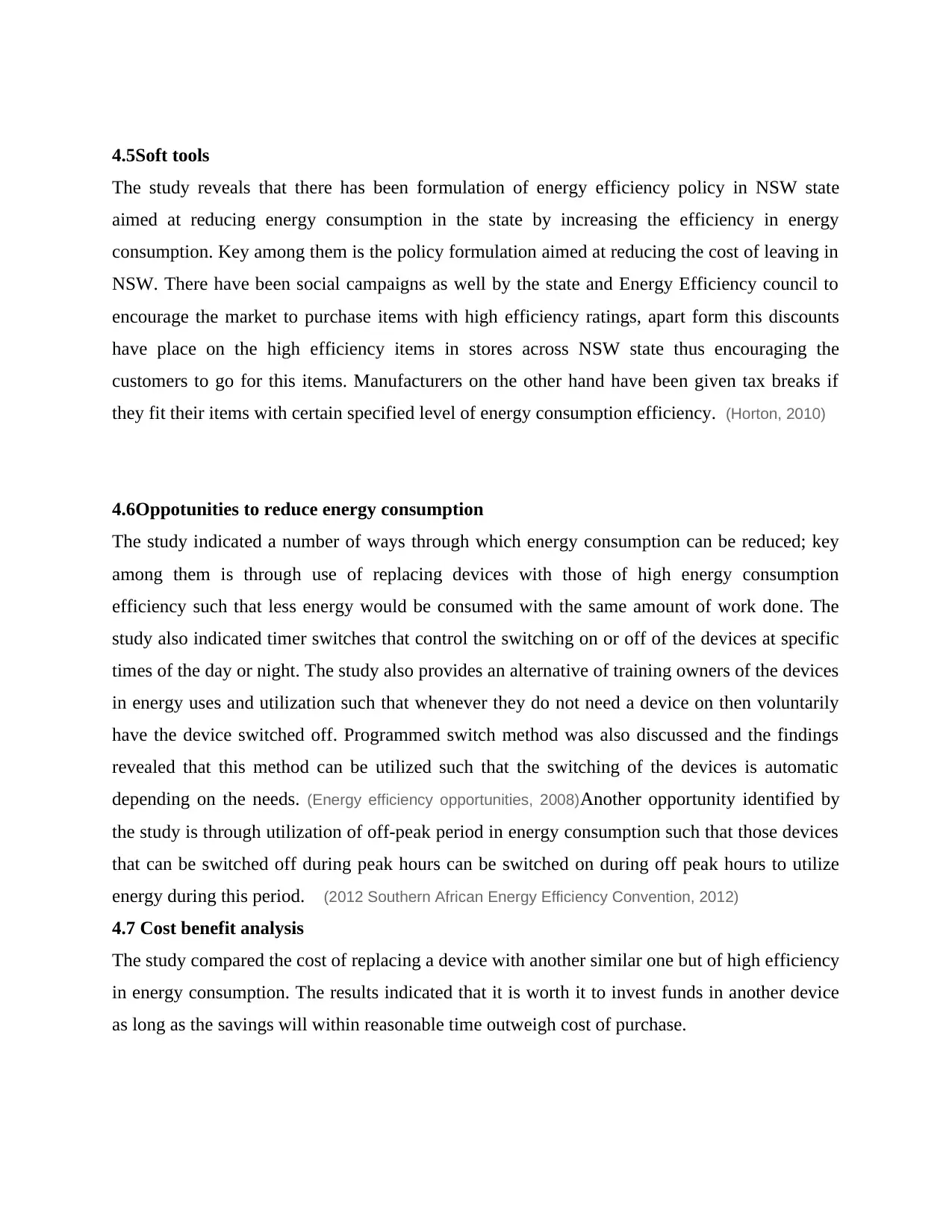
4.5Soft tools
The study reveals that there has been formulation of energy efficiency policy in NSW state
aimed at reducing energy consumption in the state by increasing the efficiency in energy
consumption. Key among them is the policy formulation aimed at reducing the cost of leaving in
NSW. There have been social campaigns as well by the state and Energy Efficiency council to
encourage the market to purchase items with high efficiency ratings, apart form this discounts
have place on the high efficiency items in stores across NSW state thus encouraging the
customers to go for this items. Manufacturers on the other hand have been given tax breaks if
they fit their items with certain specified level of energy consumption efficiency. (Horton, 2010)
4.6Oppotunities to reduce energy consumption
The study indicated a number of ways through which energy consumption can be reduced; key
among them is through use of replacing devices with those of high energy consumption
efficiency such that less energy would be consumed with the same amount of work done. The
study also indicated timer switches that control the switching on or off of the devices at specific
times of the day or night. The study also provides an alternative of training owners of the devices
in energy uses and utilization such that whenever they do not need a device on then voluntarily
have the device switched off. Programmed switch method was also discussed and the findings
revealed that this method can be utilized such that the switching of the devices is automatic
depending on the needs. (Energy efficiency opportunities, 2008)Another opportunity identified by
the study is through utilization of off-peak period in energy consumption such that those devices
that can be switched off during peak hours can be switched on during off peak hours to utilize
energy during this period. (2012 Southern African Energy Efficiency Convention, 2012)
4.7 Cost benefit analysis
The study compared the cost of replacing a device with another similar one but of high efficiency
in energy consumption. The results indicated that it is worth it to invest funds in another device
as long as the savings will within reasonable time outweigh cost of purchase.
The study reveals that there has been formulation of energy efficiency policy in NSW state
aimed at reducing energy consumption in the state by increasing the efficiency in energy
consumption. Key among them is the policy formulation aimed at reducing the cost of leaving in
NSW. There have been social campaigns as well by the state and Energy Efficiency council to
encourage the market to purchase items with high efficiency ratings, apart form this discounts
have place on the high efficiency items in stores across NSW state thus encouraging the
customers to go for this items. Manufacturers on the other hand have been given tax breaks if
they fit their items with certain specified level of energy consumption efficiency. (Horton, 2010)
4.6Oppotunities to reduce energy consumption
The study indicated a number of ways through which energy consumption can be reduced; key
among them is through use of replacing devices with those of high energy consumption
efficiency such that less energy would be consumed with the same amount of work done. The
study also indicated timer switches that control the switching on or off of the devices at specific
times of the day or night. The study also provides an alternative of training owners of the devices
in energy uses and utilization such that whenever they do not need a device on then voluntarily
have the device switched off. Programmed switch method was also discussed and the findings
revealed that this method can be utilized such that the switching of the devices is automatic
depending on the needs. (Energy efficiency opportunities, 2008)Another opportunity identified by
the study is through utilization of off-peak period in energy consumption such that those devices
that can be switched off during peak hours can be switched on during off peak hours to utilize
energy during this period. (2012 Southern African Energy Efficiency Convention, 2012)
4.7 Cost benefit analysis
The study compared the cost of replacing a device with another similar one but of high efficiency
in energy consumption. The results indicated that it is worth it to invest funds in another device
as long as the savings will within reasonable time outweigh cost of purchase.

4.8Best option
The report revealed that the best option in reducing energy consumption for both devices is by
replacing them with devices of high efficiency in energy consumption.
The report revealed that the best option in reducing energy consumption for both devices is by
replacing them with devices of high efficiency in energy consumption.
Secure Best Marks with AI Grader
Need help grading? Try our AI Grader for instant feedback on your assignments.
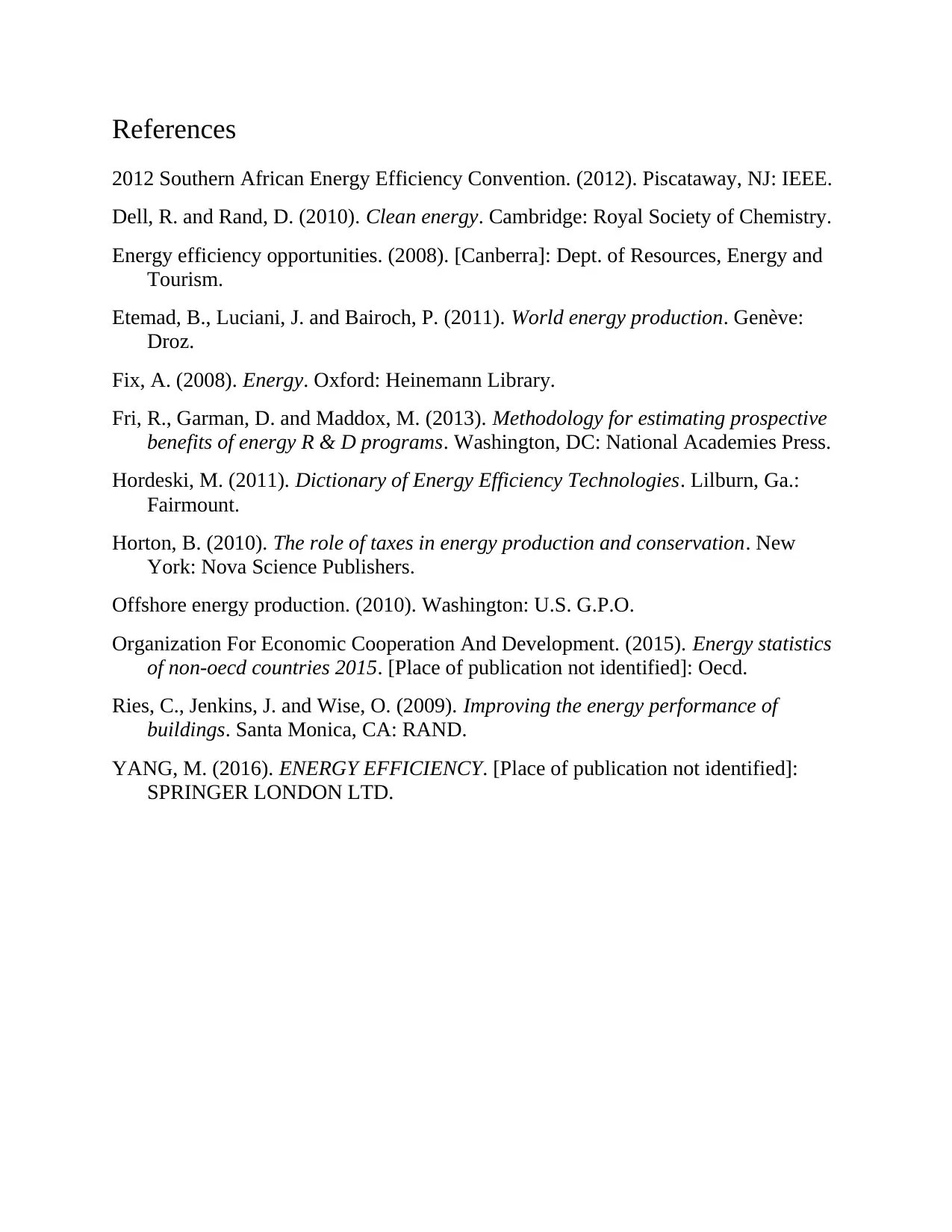
References
2012 Southern African Energy Efficiency Convention. (2012). Piscataway, NJ: IEEE.
Dell, R. and Rand, D. (2010). Clean energy. Cambridge: Royal Society of Chemistry.
Energy efficiency opportunities. (2008). [Canberra]: Dept. of Resources, Energy and
Tourism.
Etemad, B., Luciani, J. and Bairoch, P. (2011). World energy production. Genève:
Droz.
Fix, A. (2008). Energy. Oxford: Heinemann Library.
Fri, R., Garman, D. and Maddox, M. (2013). Methodology for estimating prospective
benefits of energy R & D programs. Washington, DC: National Academies Press.
Hordeski, M. (2011). Dictionary of Energy Efficiency Technologies. Lilburn, Ga.:
Fairmount.
Horton, B. (2010). The role of taxes in energy production and conservation. New
York: Nova Science Publishers.
Offshore energy production. (2010). Washington: U.S. G.P.O.
Organization For Economic Cooperation And Development. (2015). Energy statistics
of non-oecd countries 2015. [Place of publication not identified]: Oecd.
Ries, C., Jenkins, J. and Wise, O. (2009). Improving the energy performance of
buildings. Santa Monica, CA: RAND.
YANG, M. (2016). ENERGY EFFICIENCY. [Place of publication not identified]:
SPRINGER LONDON LTD.
2012 Southern African Energy Efficiency Convention. (2012). Piscataway, NJ: IEEE.
Dell, R. and Rand, D. (2010). Clean energy. Cambridge: Royal Society of Chemistry.
Energy efficiency opportunities. (2008). [Canberra]: Dept. of Resources, Energy and
Tourism.
Etemad, B., Luciani, J. and Bairoch, P. (2011). World energy production. Genève:
Droz.
Fix, A. (2008). Energy. Oxford: Heinemann Library.
Fri, R., Garman, D. and Maddox, M. (2013). Methodology for estimating prospective
benefits of energy R & D programs. Washington, DC: National Academies Press.
Hordeski, M. (2011). Dictionary of Energy Efficiency Technologies. Lilburn, Ga.:
Fairmount.
Horton, B. (2010). The role of taxes in energy production and conservation. New
York: Nova Science Publishers.
Offshore energy production. (2010). Washington: U.S. G.P.O.
Organization For Economic Cooperation And Development. (2015). Energy statistics
of non-oecd countries 2015. [Place of publication not identified]: Oecd.
Ries, C., Jenkins, J. and Wise, O. (2009). Improving the energy performance of
buildings. Santa Monica, CA: RAND.
YANG, M. (2016). ENERGY EFFICIENCY. [Place of publication not identified]:
SPRINGER LONDON LTD.
1 out of 11
Your All-in-One AI-Powered Toolkit for Academic Success.
+13062052269
info@desklib.com
Available 24*7 on WhatsApp / Email
![[object Object]](/_next/static/media/star-bottom.7253800d.svg)
Unlock your academic potential
© 2024 | Zucol Services PVT LTD | All rights reserved.